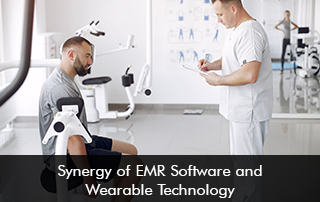A revolutionary confluence in the rapidly changing field of healthcare technology is changing how we see and handle patient well-being. The smooth integration of wearable technologies with Electronic Medical Records (EMR) software is at the forefront of this change. This mutually beneficial partnership has the potential to actively include people in their journey toward well-being in addition to just keeping an eye on their health. Come explore the revolutionary relationship between wearable technology and EMR software, and how this power couple is about to completely change the way that patients are cared for.
Benefits of EMR and Wearable Tech Integration:
Now, let’s delve into the tangible advantages brought forth by the collaborative integration of Electronic Medical Records (EMR) software and wearable technology. This dynamic synergy not only elevates the quality of patient care but also introduces transformative possibilities for proactive healthcare management and improved overall well-being.
Seamless Data Integration:
- EMR software seamlessly integrates with wearable devices, ensuring a continuous flow of patient data.
- Real-time health metrics, such as heart rate, sleep patterns, and physical activity, are automatically recorded and updated in the patient’s electronic health record.
Proactive Health Monitoring:
- Wearable devices empower individuals to take control of their health by offering continuous monitoring outside traditional healthcare settings.
- Physicians can access comprehensive, real-time data, allowing for proactive interventions and personalized treatment plans.
Patient Engagement and Compliance:
- Wearables promote patient engagement by fostering a sense of responsibility for one’s health.
- Automated reminders, medication alerts, and personalized health goals enhance patient compliance and adherence to treatment plans.
Enhanced Chronic Disease Management:
- For patients with chronic conditions, wearable technology provides a means of continuous monitoring, leading to early detection of anomalies.
- EMR systems analyze this data, enabling healthcare providers to adjust treatment plans and reduce the risk of complications.
Data-Driven Insights:
- The integration of wearable data into EMR systems enables healthcare professionals to derive meaningful insights.
- Patterns and trends in patient health can be identified, contributing to more informed decision-making and personalized care strategies.
Telemedicine and Remote Patient Monitoring:
- Wearables play a crucial role in telemedicine, facilitating remote patient monitoring and virtual consultations.
- Healthcare providers can conduct real-time assessments, review vital signs, and adjust treatment plans, all while the patient remains in the comfort of their home.
Challenges and Considerations:
Data Security and Privacy Concerns:
- Protecting sensitive health data from potential breaches during the collection, transmission, and storage processes.
- Implementing robust encryption methods and access controls to ensure patient information remains confidential.
Interoperability Issues:
- Overcoming challenges related to the interoperability of different wearable devices with existing EMR systems.
- Establishing standardized protocols for data exchange to enable seamless communication between devices and systems.
Integration Complexity:
- Addressing the complexity of integrating diverse wearable technologies into existing EMR infrastructures.
- Utilizing middle-ware solutions and standardized APIs to simplify the integration process and ensure compatibility.
User Adoption and Training:
- Encouraging healthcare professionals and patients to adopt and effectively use wearable technology.
- Providing comprehensive training programs to ensure users are proficient in utilizing the integrated systems for improved patient outcomes.
Regulatory Compliance:
- Adhering to regulatory requirements governing the use of wearable technology in healthcare.
- Ensuring compliance with data protection laws, healthcare regulations, and standards applicable to medical devices.
Standardization Efforts:
- Supporting industry initiatives to standardize data formats and communication protocols.
- Promoting interoperability through the adoption of common standards for seamless integration across different wearable devices.
Data Accuracy and Reliability:
- Ensuring the accuracy and reliability of data collected by wearable devices.
- Implementing validation processes to verify the quality of the data integrated into EMR systems for informed decision-making.
Cost Implications:
- Assessing the potential costs associated with implementing and maintaining the integration of wearable technology with EMR systems.
- Considering budgetary constraints and resource allocation for successful and sustainable technological advancements.
Patient Education and Consent:
- Educating patients about the benefits and risks associated with the integration of wearable technology.
- Establishing clear and informed consent processes to ensure patients understand how their data will be used and shared.
Ethical Considerations:
- Addressing ethical considerations related to data ownership, informed consent, and responsible use of patient-generated health data.
- Ensuring ethical practices in the collection, storage, and utilization of data to maintain trust between healthcare providers and patients.







